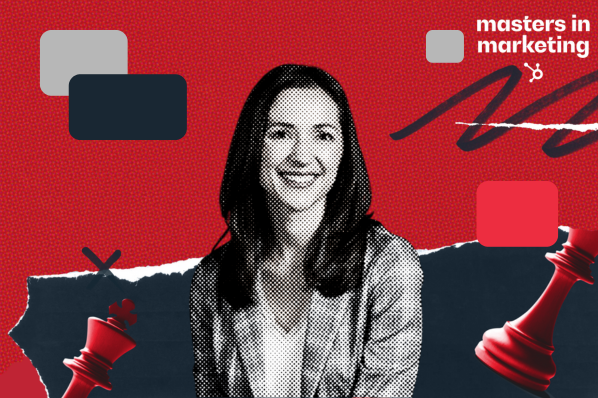The way most marketing teams approach AI is probably the way I approach my inbox at 4:59 PM on a Friday.

With reckless optimism and zero follow-through.
But Katie Miserany, SurveyMonkey’s Chief Communication Officer and SVP of Marketing, thinks the real problem isn’t AI — it’s that most marketers have forgotten a fundamental truth: Just because you can talk about something doesn’t mean you should.

Katie Miserany
Chief Communications Officer and SVP, Marketing at SurveyMonkey
- Claim to fame: Miserany’s proud accomplishment isn’t a single launch or campaign… It’s the people. She’s felt fortunate to meet, hire, and mentor incredibly talented people who’ve chosen to follow Katie from team to team and company to company. Miserany told me, “Building workplaces people want to join again and again tells me I’m creating environments where people can grow, do their best work, and feel genuinely supported. That’s the kind of legacy that makes me proud.”
Lesson one: Stop doing random acts of marketing.
Remember the TikTok ban?
SurveyMonkey’s team was excited. Almost immediately, they knew they needed to hop on the trend by conducting a survey on how people were feeling about TikTok.
(I can relate. I remember sitting in an airport lounge writing a panic-induced blog post on the TikTok ban because HubSpot felt we should cover it, too.)
And just as Miserany’s team prepared to launch their findings… TikTok released its own study.
“Guess what the media covered?” Miserany says with a laugh. “It was TikTok’s study.”
Emily Kramer (a Masters in Marketing alum) has a phrase for this temptation to jump on every trending topic just because you can. She calls it “random acts of marketing.”
And Miserany doesn’t think it’s going to cut it anymore.
“To scale in this new chapter of B2B marketing, the foundation needs to be stronger. You can’t do random acts of marketing. You need to set your foundation, understand your customers’ needs, and then have the discipline and discernment to only build from that foundation instead of chasing shiny things,” she tells me.
More volume without a strong foundation? That’s just noise.
Lesson two: Build your foundation first, then repeat it everywhere.
When she was the senior director at Sheryl Sandberg’s Foundation, Miserany worked on a campaign aimed at getting men to be allies to women in the workplace.
She and her team did something that most marketers would find agonizing: They spent forever in the planning phase.
“You’re a small organization… So you would think the temptation would be to just start running [with something],” Miserany tells me.
But instead, “we spent so long beating the idea up.”
They asked themselves: What’s the cost of doing this? What’s the cost of not doing it?
Once they’d meticulously nailed down their vision for the campaign, execution felt “almost effortless.” Even better, it made consistency possible.
The team created something called “the well” — a document that outlined exactly how they were supposed to talk about everything. If something was called “stunning” in the well, you couldn’t call it “gorgeous.” You stuck to the script, and you had to make a real case for deviating from it.
“The repetition of this exact language is really important for breaking through,” Miserany explains.
“And then you need all of your channels doing the same exact thing to have any hope of someone seeing it, recognizing it, remembering it, [and] feeling good about your brand.”
The lesson for leaders: Spend time to nail the planning and trust your marketers to tell the right story every time.
Lesson three: Try scaffolding.
Miserany gets frustrated when she sees good marketing ideas executed in a vacuum.
Her solution? What she calls scaffolding.
Recently, SurveyMonkey’s brand leader chatted with Miserany about the opportunity to do a sponsorship at F1.
But the idea didn’t fully excite Miserany until she heard what could go along with it — like a conference, a webinar, and a follow-up email nurture campaign.
“An F1 sponsorship sounds cool, but it doesn’t really get me that excited about the potential for the business until you can scaffold it with all these other things and surround it with different tactics and different storytelling, to make it helpful to our customers.”
The takeaway for SMB marketers? Before launching any campaign, ask yourself: What else can we build around this? How can we turn one good idea into an integrated experience that surrounds our prospects in a way that’s actually helpful?
Because in a world where everyone has access to AI and can crank out content, the brands that break through won’t be the ones doing more isolated tactics. They’ll be the ones doing fewer things, better.
Bonus: The SurveyMonkey feature SMB marketers are sleeping on.
Before we wrapped, Miserany told me something that surprised me: You can use SurveyMonkey to survey people you don’t know.
Want to test logo designs? Ask about product preferences? Validate a business idea? You can reach a targeted audience (including specific industries, locations, or demographics) without hiring an expensive research firm.
Lingering Questions
THIS WEEK’S QUESTION
“As marketers, we often talk about authenticity and alignment but those words can become buzzwords fast. How do you ensure your team stays connected to real people and not just the performance of connection?” —Bryetta Calloway, Co-founder and CEO, Stories Seen
THIS WEEK’S ANSWER
Miserany says: You absolutely must know what your customers care about and want from you. I think a lot of brands today want to be “cool” and that’s contributing to the great flattening of brands and content across the ecosystem right now.
At SurveyMonkey, we don’t aspire to be cool. We want to be the lovable nerd who you want to partner with in your high school chem lab because you know we’ll do all the work and make you look smart. This is how you differentiate today: know the value you provide in your customers’ eyes and maximize it in everything you do.
NEXT WEEK’S QUESTION
Miserany asks: Every leader must justify marketing and brand investment with hard numbers. How do you functionally bridge the gap between creative, intangible brand value and tangible financial outcomes, and how do you justify that brand investment to key stakeholders?












